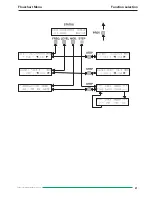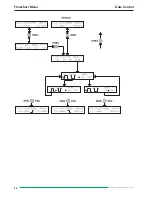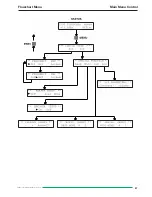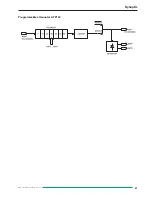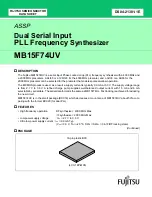
17
Subject to change without notice
Syntax:
:FREQuency[:CW|:FIXed] <NUM>
(1)
:FREQuency[:CW|:FIXed]?
(2)
The line (1) allows you to modify the carrier frequency, the
<NUM> parameter is a NR1 or NR2 or NR3 number in the
range covered by the instrument.None unit must follow the
number, the Hz unit is the default one. The value is garbled
(same as the keypad) to the resolution. The «CW» and
«FIXed» options have no particular effect on the instrument,
they are present for compatibility with programs existing in the
SCPI standard. The line (2) asks the current (carrier) frequency
to the instrument. It sends back a string representing a NR3
decimal number.
Examples:
:FREQ 678E+6
Set the frequency 678MHz
:FREQUENCY 34000000
Set the frequency 34MHz
:FREQ?
Ask the frequency
:FREQ:FIX 900E+6
Set the frequency 900MHz
Commands tree - PHASE
It summarizes the commands for selecting the source of the
reference signal.
Syntax:
:PHASe:SOURce INTern | EXTern
(1)
:PHASe:SOURce?
(2)
The line (1) allows you to switch the reference. Only one of the
2 parameters must be present: «INTern» for turning the
internal reference on, or «EXTern» for turning the external
reference on.
The line (2) asks which source is currently on to the instrument.
It sends back the strings «INT» or «EXT» corresponding to the
2 options described above.
Note:
It is strongly advised to check the state you have got
after a command (1) (for example simply with the query
command (2)).
Examples:
:PHAS:SOURCE EXT
Turn external ref
:PHASE:SOUR?
Query
:PHAS:SOUR?
Idem above but shorter
Commands tree - PULM (PULse Modulation)
It summarizes the commands of the GATE modulation.
Syntax:
:PULM:STATe 1 | ON | 0 | OFF
(1)
:PULM:STATe?
(2)
The line (1) allows you to turn on or off the GATE modulation.
The «1» or «ON» parameters turn the modulation on and «0»
or «OFF» turn the modulation off (if present). The line (2)
allows you to pick up the state of the GATE modulation. The
instrument sends back «0» (char zero) if no modulation, «1»
(char one) in case of modulation.
:PULM:POLarity NORMal | INVert
(3)
:PULM:POLarity?
(4)
The line (3) allows you to set the validation level of the GATE
modulation, the NORMal parameter is for a high level validation,
and INVert is for a low level validation.
The line (4) asks the enabling level state. The instrument sends
back «1» for high level (NORMal), «0» for low level (INVert).
Commands tree - AM (Amplitude Modulation)
It summarizes the commands of the AM.
Syntax:
:AM[:DEPTh] <NUM>
(1)
:AM[:DEPTh]?
(2)
The line (1) allows you to modify the depth of modulation. The
<NUM> parameter is a NR2 number in the range covered by
the instrument. None unit must follow the number, % unit is
the default one. If the value has an accuracy higher than the
resolution (0.1%), the number is rounded to the corresponding
digit. The line (2) asks the current depth of modulation to the
instrument. It sends back a NR2 number corresponding to the
resolution (one digit after the decimal point) without the unit.
:AM:SOURce INTern | EXTern
(3)
:AM:SOURce?
(4)
The line (3) allows you to set the modulation source and at the
same time turns the FM on.
The parameters are clear enough. The line (4) asks the source
modulation to the instrument. It sends back the strings INT or
EXT (not INTERN or EXTERN). If the AM is turned off, the string
INT is sent back because this source is the default setting for
the «AM:STAT 1» command (the operation is the same as the
keypad).
:AM:INTern:FREQuency <NUM>
(5)
:AM:INTern:FREQuency?
(6)
The line (5) allows you to change the frequency of the internal
modulation signal. The <NUM> parameter is a NR1 or NR2 or
NR3 number in the range covered by the instrument. None
unit must follow the number, Hz unit is the default one. The
value is garbled (same as the keypad) to the resolution.
The line (6) asks the current modulation frequency to the
instrument. It sends back a string representing a NR3 decimal
number.
:AM:INTern:SHAPe SIN | SQU | TRI | +RP | -RP
(7)
:AM:INTern:SHAPe?
(8)
The line (7) allows you to change the shape of the internal
modulation signal.The parameters are: SIN for a sine signal,
SQU for square, TRI for triangle, +RP for a positive ramp, and
-RP for a negative ramp.
The line (8) asks the current shape to the instrument. It sends
back the same strings as the corresponding command
parameters above.
:AM:STATe 0 | OFF | 1 | ON
(9)
:AM:STATe?
(10)
Operation - Commands tree
Summary of Contents for HM8134-2
Page 1: ...Instruments MANUAL HANDBUCH MANUEL Programmable Synthesizer HM8134 2 ENGLISH...
Page 2: ...LEER...
Page 21: ...21 Subject to change without notice Flowchart Menu Function selection...
Page 22: ...22 Subject to change without notice Flowchart Menu Step Control...
Page 23: ...23 Subject to change without notice Flowchart Menu Amplitude Modulation Control...
Page 24: ...24 Subject to change without notice Flowchart Menu Phase Modulation Control...
Page 25: ...25 Subject to change without notice Flowchart Menu Frequency Modulation Control...
Page 26: ...26 Subject to change without notice Flowchart Menu Gate Control...
Page 27: ...27 Subject to change without notice Flowchart Menu Main Menu Control...
Page 28: ...28 Subject to change without notice Referency loop CREF Synoptic Principal loop PLL1 134...
Page 29: ...29 Subject to change without notice Secondary loop PLL2 134 Synoptic Transposition TRA 134...
Page 31: ...31 Subject to change without notice Programmable attenuator ATP134 Synoptic...
Page 37: ...37 Subject to change without notice...
Page 38: ...38 Subject to change without notice...
Page 39: ...LEER...



















